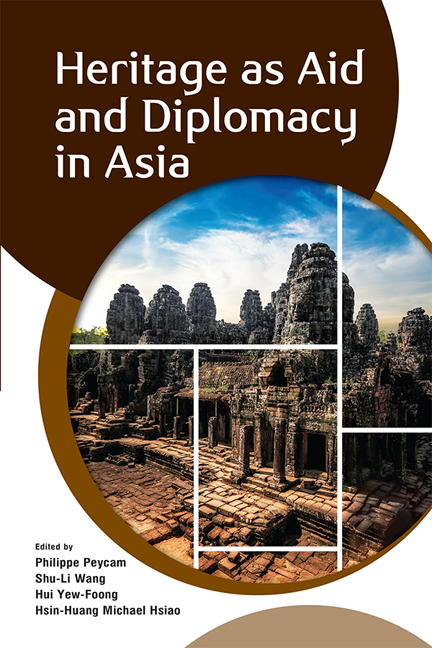Book contents
- Frontmatter
- Contents
- Contributors
- 1 Heritage as Aid and Diplomacy in Asia: An Introduction
- 2 World Heritage and WikiLeaks: Territory, Trade and Temples on the Thai-Cambodian Border
- 3 Heritage Making – Aid For Whom? The Genealogy of Expert Reports in the Hands of Politics and Their Impact in the Case of Preah Vihear
- 4 The International Coordinating Committee for Angkor: A World Heritage Site as an Arena of Competition, Connivance and State(s) Legitimation
- 5 Legacies of Cultural Philanthropy in Asia
- 6 To Help or Make Chaos? An Ethnography of Dutch Expertise in Postcolonial Indonesia
- 7 Heritage Conservation as a Tool for Cultural Diplomacy: Implications for the Sino-Japanese Relationship
- 8 From Ideological Alliance to Identity Clash: The Historical Origin of the Sino-Korean Goguryeo Controversies
- 9 Nationalism, Politics and the Practice of Archaeology in Afghanistan: A Case Study of Bamiyan
- 10 Disappearing Voices: The Politics and Practice of Safeguarding Kunqu Opera in the People’s Republic of China
- 11 Neoliberalizing Heritage: International Agencies and the Local Dynamics of Heritage Conservation in Bali, Indonesia
- 12 Heritage Conservation as Trickle-Down Development
- Index
8 - From Ideological Alliance to Identity Clash: The Historical Origin of the Sino-Korean Goguryeo Controversies
Published online by Cambridge University Press: 10 November 2020
- Frontmatter
- Contents
- Contributors
- 1 Heritage as Aid and Diplomacy in Asia: An Introduction
- 2 World Heritage and WikiLeaks: Territory, Trade and Temples on the Thai-Cambodian Border
- 3 Heritage Making – Aid For Whom? The Genealogy of Expert Reports in the Hands of Politics and Their Impact in the Case of Preah Vihear
- 4 The International Coordinating Committee for Angkor: A World Heritage Site as an Arena of Competition, Connivance and State(s) Legitimation
- 5 Legacies of Cultural Philanthropy in Asia
- 6 To Help or Make Chaos? An Ethnography of Dutch Expertise in Postcolonial Indonesia
- 7 Heritage Conservation as a Tool for Cultural Diplomacy: Implications for the Sino-Japanese Relationship
- 8 From Ideological Alliance to Identity Clash: The Historical Origin of the Sino-Korean Goguryeo Controversies
- 9 Nationalism, Politics and the Practice of Archaeology in Afghanistan: A Case Study of Bamiyan
- 10 Disappearing Voices: The Politics and Practice of Safeguarding Kunqu Opera in the People’s Republic of China
- 11 Neoliberalizing Heritage: International Agencies and the Local Dynamics of Heritage Conservation in Bali, Indonesia
- 12 Heritage Conservation as Trickle-Down Development
- Index
Summary
Goguryeo (Koguryo in old romanization) is the name of an ancient kingdom that existed from 37 BCE to 668 CE in present-day North Korea and Northeast China (also known as Manchuria), as well as small portions of South Korea and the Russian Far East. In succession, its capitals were in the present-day Chinese county of Huanren (34 BCE – 3 CE), the Chinese city of Ji’an (3–427 CE) and North Korea's capital city of Pyongyang (427–668 CE). Historical relics, particularly tombs and city walls, abound in these places and their environs. During the seventh century, Goguryeo resisted numerous invasions from successive dynasties in the Chinese hinterland, particularly the Sui Dynasty (581–618 CE) and the Tang Dynasty (618–907 CE), and experienced continuous warfare with other regimes on the Korean Peninsula, such as Silla (57 BCE – 935 CE) and Baekje (18 BCE – 660 CE). The period during which Goguryeo existed is termed the era of the Three Kingdoms of Korea (57 BCE – 668 CE) because Goguryeo, Silla and Baekje were the three major powers on the Korean Peninsula. Goguryeo was eventually destroyed by a joint force of Silla and the Tang in 668, which led to the Unified Silla Era (668–935 CE) and to the Tang's rule in northern Korea.
Surprisingly, Goguryeo became an issue of severe contention among Northeast Asian countries in the early twenty-first century, more than thirteen centuries after the kingdom's collapse. A controversy among China and the two Koreas involving governments and academia over whether Goguryeo was a Korean dynasty or a local minority regime of ancient China broke out when North Korea and China nominated their respective Goguryeo relics for UNESCO World Heritage status. While nominations from both countries were eventually successful, the controversy persisted and had a significant impact on international relations in Northeast Asia.
This chapter probes the historical origin of this early twenty-first century controversy by placing it within the modern history of the three countries involved.
- Type
- Chapter
- Information
- Heritage as Aid and Diplomacy in Asia , pp. 190 - 225Publisher: ISEAS–Yusof Ishak InstitutePrint publication year: 2020



